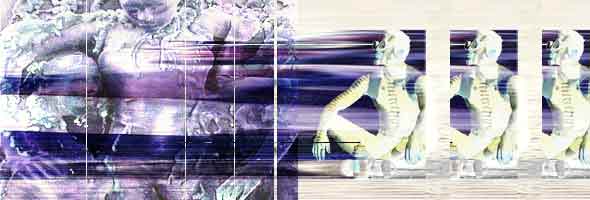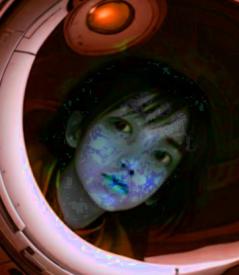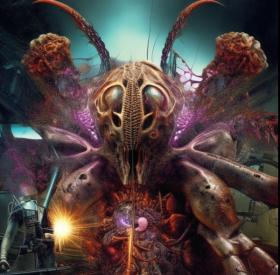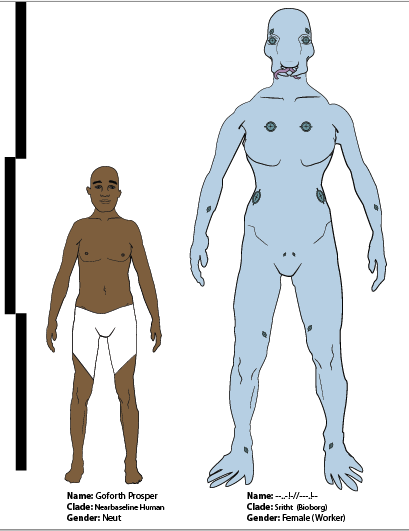BY LETTER
Biotech Cyborg (Bioborg)
Bioborgs are humans, animals, or other lifeforms, heavily modified via biocircuitry, biomachinery, biosymbers, bionano, wetware, etc (collectively: bioware). No inorganic components (other than some occasional support or reinforcing structures) are used at all for any of these augmentations. The reason for this may be aesthetic, ideological, cultural, religious, or pragmatic. Bioware mods may range from simple skin-patches to complete reorganising of skeletal, muscular, nervous, digestive, and/or pulmonatory systems. Sometimes the modifications are so subtle that on the surface the bioborg looks just like an ordinary baseline or nearbaseline of its original species. At other times they are so radical as to make the original genomorph of the bioborg indeterminable.
The advantage of using organic mods are obvious. The mod becomes part of the individual's body, is holistically and integrally a part of the same body and (in a few belief systems) chi-energy system. Neo-taoists, yogis, athletes, holistic healers, and a number of martial arts schools, all prefer bioware over cyberware for just such chi-integration purposes. Advanced biomedical engineering systems are self-repairing in the same way as any other organic component. Instead of an external power source, ordinary food provides fuel, just as it does to the rest of the body.
The increase in food-intake naturally differs according to the size, purpose, efficiency, activity and metabolism of the implant; anywhere from negligible to an entire order of magnitude - many bioborgs have their entire alimentary system reengineered to cope with the increased requirements of digestion, and this can involve genetically engineered intestinal flora and multiple specialised digestive tracts capable of assimilating a wide range of minerals, metals, fluids and energy-rich compounds such as hydrocarbons.
 Image from Bernd Helfert |
Although good quality bioware should adapt themselves to any host body, this is rarely the case in practice. More often a course of medical nano, immunosupressants, and pheno-gengineering are necessary to modify the host so it doesn't reject the implant. Eventually the implant should acquire the hosts own genetic signature. Depending on the size, nature, and quality of the mod this may take anywhere from only a few hours to a period of days, weeks, or at most several months. There is also the task of adjusting to the new mod via physiotherapy, training, and wetware.
Bioware can be used for almost anything inorganic cyberware can. There are biocomputers, biobatteries, bio-remotes, even biolasers which use special light-producing and light conducting bionanogenic cells. A lot of bioware, such as ch'i-batteries, body gestalts, erotogens, pheromones, etc , have no hylotech equivalent. However, bioware suffers from a lack of modularity, and it is usually fairly traumatic to the body to remove or insert a piece of bioware; unlike drytech which can be done as easily as unplugging the old unit and replacing it with the new.
Bioware is most often used by biocentrist empires and polities like the Zoeific Bioplity and the ill-fated Softbots and Biovirate, Houses like the Genen and the Stevens, and various biosupremist and anthropist groups. It is also very popular among Fomac traders, Erotogini, Gothics of various persuasions, heterodox rianths, a large number of provolve species, and many other important cultures and subcultures.
  Images from Steve Bowers and Artbreeder AI, Keith Wigdor and Bing Image Creator | |
| Bio-borgs adopt many different forms and bodytypes. Left - a humanoid bio-borg with bioluminescent skin and relatively unobtrusive augmentations; right - a radically altered arthroform bio-borg | |
Articles
- Alchemists, The - Text by David Hallberg
Enigmatic bioborg clade, today found in only a few scattered habitats, but around whom a web of myths and tales has grown, reinforced by their peculiar, often bizarre appearance and manners. - Astomi - Text by Michael Walton
The Astomi are among the more unusual bioborg clades. They stand as a dual example of the creativity of genetic engineers and the danger of overspecialization - Biaioid - Text by Updated 2019 by Rakuen07
A rare form, an aioid with integrated biological parts. Vecs, bots and other ai will sometimes add on biological enhancements or organs for various reasons. - Bioborg cooling systems - Text by Brian McKinley, John B, and M. Alan Kazlev
Technologies for maintaining comfortable body temperature for bioborgs whose augments produce significant waste heat. - Biobots - Text by M. Alan Kazlev
Bioengineered organisms, e.g. bacteria, neogens, etc, modified to act out specific orders. Biobots of some form or another have been used since the middle information period for nanotech (bionano), production, monitoring, medicine and much more. - Biomachine - Text by M. Alan Kazlev and AI Vin
Any machine or device based on organic components rather than inorganic mechanisms. - Bionano, Bionanotechnology - Text by M. Alan Kazlev
Any molecular nanotechnology based on such biomolecules, genetically modified micro-organism or other biotech. - Biophone - Text by Ernst Stavro Blofeld
Geneered organisms whose entire raison d'etre is to make music. - Bioxox - Text by Steve Bowers
Biological copy of an original bioid, often created using engenerator technology - Bluesky Bioxox - Text by Steve Bowers
The four biological copies of Benedita Bluesky. - Bright Cats - Text by Achaz the Transavant
- Cymbiotic - Text by John B
Beings unable to self-reproduce without physical/nanotech manipulation of their bodies. - Fenestra - Text by M. Alan Kazlev
[1] Biont anatomy: a natural hole or opening in a bone or other hard structure, to allow the passage of nerves, blood-vessels, etc.
[2] Bioborg armor: a small opening for feedlines, and other vessels. - Five Morph, The - Text by M. Alan Kazlev
A martial arts warrior clade based on five morphotypes. - Gigantes - Text by Omega Tyrant
Gigantes- A sub clade of highly cyborged and bioborged Nephilim designed to be able to engage in "riskier" activities. - Hectonitheres - Text by John B
The 'hundred handed ones' are a clade of multi-instance bioborgs. That is, each 'individual' is made up of between 30 and 100 (usually around 50) biological and nanotic bodies. Typically the bodies of such sophonts are hominid in appearance and rough functionality, but it is not unusual to have multiple bauplans covered in a single sophonce. It is unusual to find such a sophont without at least a few hominid-style bodies, however, for ease of interface with the rest of the worlds. - Hermophromorph - Text by M. Alan Kazlev
Erotogenic with genitals and other characteristics of both genders equally developed, especially in an exaggerated or augmented fashion. Alternatively, any being who has so modified emself. - Heteromorphs - Text by Steve Bowers
Modosophont bionts, usually but not always humans, who have altered their physical form until they are substantially different from their original form. - Hian Dao - Text by Michael Walton
A hybrid clade, with features in common with animal, plant, and robotic/vec phyles - Kabristaanis - Text by Kirran Lochhead Strang
A radical religious biopunk subculture from Interplanetary Age South Asia on Old Earth. Outgrowths of the subculture into Solsys space had influences upon certain religious groups and genetekker-related cultures. - R'Foxxans, The - Text by AI Vin
A polity of superbright symbiont bioborgs that emerged from a mix of the various nearbaseline humans that colonized the ACAF-37274637-8633 system in the Sagittarius Sector. - Skeletoids - Text by Steve Bowers
Sophonts with minimal artificial muscle mass, leading to an emaciated, 'skeletal' appearance - Sritht - Text by Liam Jones
Heavily derived eusocial hominid tweak/bioborg clade. - Tupilaks - Text by Anders Sandberg
Composite bioborgs or neogens, built from cultured organs or limbs. While not often seen much use outside specialised applications, building bioborgs from modular parts is sometimes more cost-effective than engineering entirely new species. - Wup - Text by Orion's Arm Editors
A loosely-defined disruptive cultural movement centered around an iridescent, blue-colored goo. - Xenomorph - Text by Steve Bowers
Any Terragen entity using an artificial alien (xenosophont) body for the purposes of cultural contact, exploration or colonisation.
Related Topics
Development Notes
Text by M. Alan Kazlev
updated Steve Bowers 2024
Initially published on 19 October 2001.
Merged the bioborg article into the bioborg topic march 8, 2025, because the content was almost identical.
updated Steve Bowers 2024
Initially published on 19 October 2001.
Merged the bioborg article into the bioborg topic march 8, 2025, because the content was almost identical.
Additional Information







